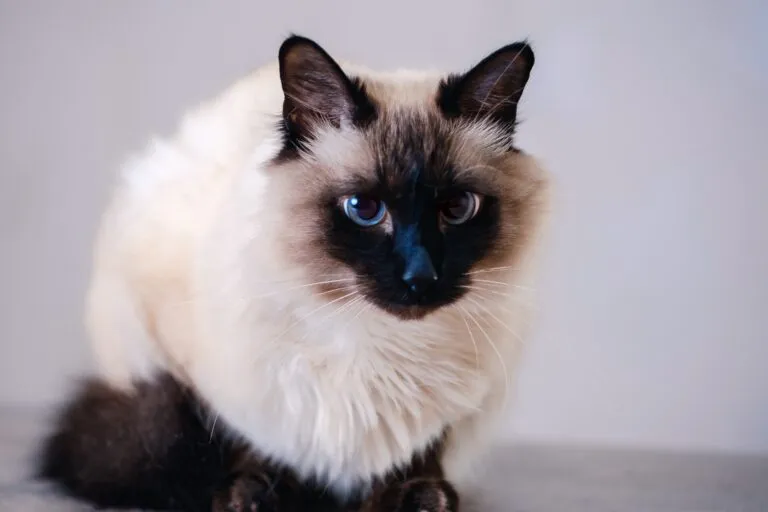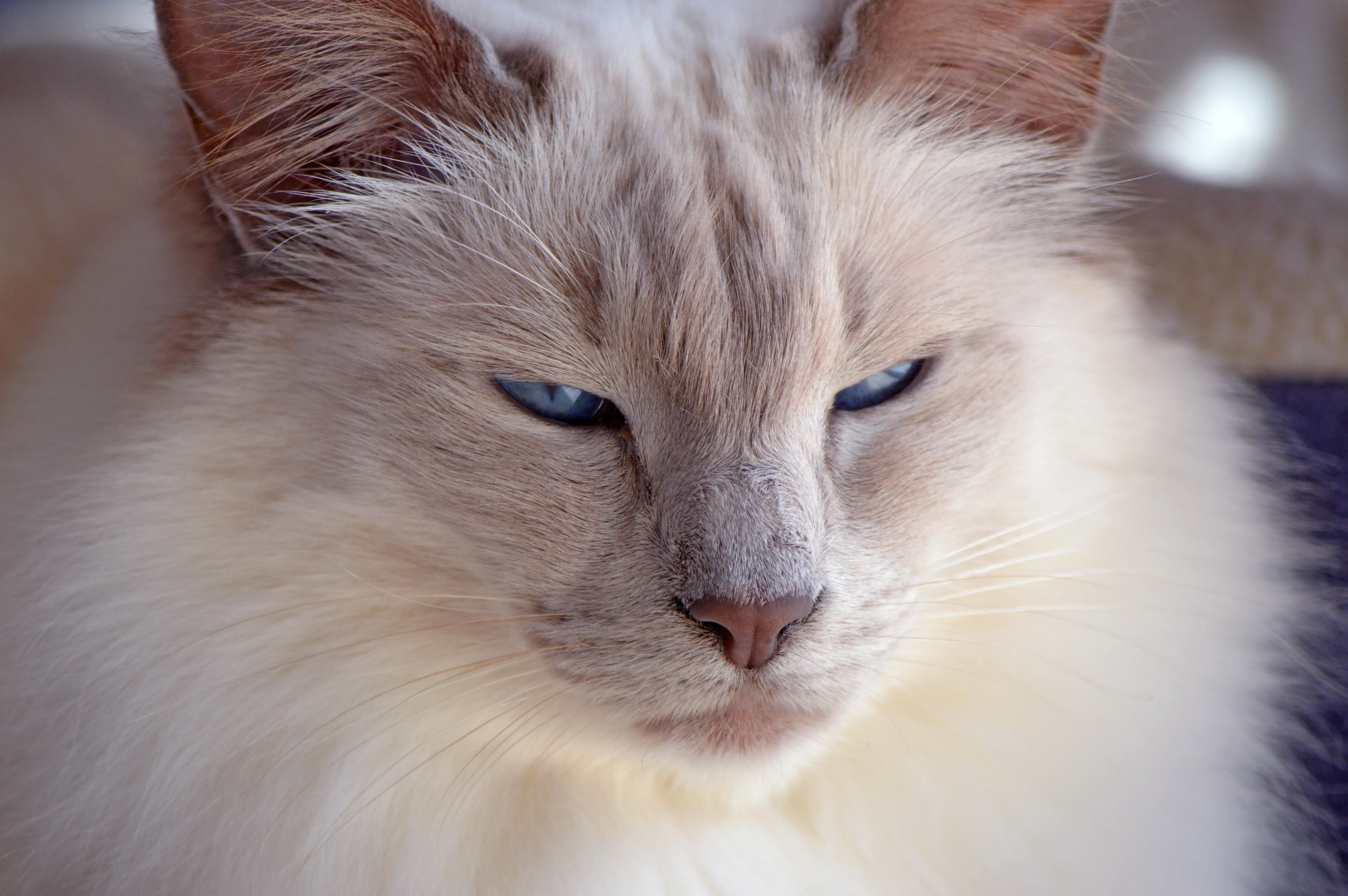Maine Coon
The Maine Coon has become one of the most popular cat breeds in the world. This is probably due to its majestic appearance, robust nature and great character.
The Balinese cat soon catches the eye of fans of the Siamese and Birman: this breed has a striking point pattern, but with semi-long fur.

© bravissimos / stock.adobe.com
Despite its name, the Balinese doesn’t come from Bali or Indonesia. It emerged from breeding rather than natural selection.
Indeed, some Siamese cats that were imported from Thailand to the US and England in the 1800s carry the longhair gene. However, these cats known as the longhair Siamese weren’t deployed for breeding. In order not to falsify the breed standard, they were sold as pets or culled if no buyer could be found. The breed was first registered in 1928 and shown at cat exhibitions. American breeders finally discovered the breed’s potential in the 1950s and started to breed it in a targeted manner. The name “Longhair Siamese” seemed too cumbersome for cat lovers, so the “Balinese” name was born. However, this doesn’t refer to the breed’s geographic origin, but the delicate, graceful manner of the cats, comparable to that of Balinese dancers.
In the 1960s and 1970s, only cats with the classic point colourings seal, chocolate, blue and lilac were permitted for Balinese breeding. At the same time, the Cat Fanciers Association named red, cream, tabby and tortoiseshell Balinese cats Javanese. This naming remains in place to this day, but often leads to confusion.
The original type of Balinese cat also underwent a change. Targeted breeding shifted the Balinese ideal from its traditional appearance to an increasingly slender physique with a triangular head and larger ears. The physique of the Balinese now resembles that of the modern Siamese. The original type is now only maintained by a few breeders.
Balinese cats are muscular but slender. Medium in size, they typically weigh between three and four kilograms – males can weigh up to five kilograms. Balinese cats look like original Siamese cats, but their fur is long and particularly bushy at the tail. The modern version of the Balinese strongly resembles the modern Siamese with its elongated body and triangular face.
Just like the Birman and Siamese, the Balinese is also a point cat. Its striking colouring immediately catches the eye: The predominantly light fur is only dark at the tips of the body like the snout, legs, tail and ears. This colouring is due to a mutation leading to deficient function of the enzyme tyrosinase and thereby disrupting production of the pigment base melanin. This leads to partial albinism and colouration of the cold body parts. Based on genetic principles, each fur colour can also occur as a point colour.
According to the European breeding association, the following colours are permitted with Balinese breeding:
Balinese cats have striking bright blue eyes. They make them look alert and intelligent and reveal their communicative and active character.
Balinese cats are often sold as supposedly being hypoallergenic. Unfortunately science has not yet produced a cat breed that can be recommended unreservedly for those allergic to cat hair. A cat allergy can be triggered by the enzymes Fel d1 and Fel d4 contained in the saliva. Indeed, the mouth fluids of Balinese cats contain a relatively low concentration of this protein.
The character of the Balinese is typical of oriental cat breeds, as they are particularly active and communicative. They are especially people-focused, love their family’s attention and loudly demand it. Intelligent Balinese cats like to be kept occupied – ideally around the clock. Intelligence toys and puzzle games are particularly popular, although cats like playing with their human family most of all. Despite being one of the more dominant cat breeds, they are suitable for families with children and other pets, such as dogs. The main thing is that there’s always something going on!
Balinese cats are low-maintenance and robust. They don’t need any special grooming or healthcare provision. Like all cats though, they do benefit from being combed or brushed once or twice a week. Cat grass and malt paste help during the moulting period in spring and autumn to excrete swallowed hairs in a natural way.
The annual check-up at the vet where your Balinese will be closely examined is also a must. Any questions can be clarified during the short examination too.
As intelligent animals, Balinese cats soon get bored. As a result, keeping oriental cat breeds in a species-appropriate manner should always involve a diverse environment with opportunities for climbing, play and hiding! Multi-level scratching trees are recommended since cats prefer elevated spots. Play houses and cat tunnels are another option for these felines. This allows your Balinese to let off steam and retreat too if required.
If you don’t want to let your Balinese loose in the great outdoors, a secured balcony or garden is a good option. Water basins, outdoor climbing trees and a bowl of cat grass provide great variety.
 © Peter Ager / stock.adobe.com
© Peter Ager / stock.adobe.com
Due to being closely related to the Siamese, Balinese cats unfortunately show some of the hereditary diseases typical of this breed. These include hypertrophic cardiomyopathy, a hereditary thickening of the cardiac muscle. A cardiac ultrasound is the tool of choice to diagnose HCM and examine breeding animals. Although hypertrophic cardiomyopathy cannot be cured, early diagnosis can allow sick animals to be excluded from the breeding process. HCM isn’t always a death sentence – cats can live a long, healthy life as family pets! However, they should be excluded from breeding to prevent the disease from being inherited.
A species-appropriate diet with plenty of healthy protein is essential for all cats. Active breeds like the Balinese often particularly need a lot of energy. Since cats can only utilise carbohydrates to a limited extent, you should primarily focus on high-quality cat food with a high proportion of meat and protein content.
Perhaps you would like to try alternative feeding methods like BARF and cooking yourself? With raw food, often known as BARF, the daily food portion consists of raw meat, a small proportion of innards and targeted supplements. A thorough training period is essential here. This way, you make sure that your cat gets everything it needs to stay healthy. The same applies for cooking cat food yourself.
As with the Siamese, there are two types of Balinese: The original, more stable breeding type and the more modern breeding variety. The latter is the more popular variety often seen at breeding exhibitions. This type of Balinese cat is becoming more and more similar to the modern Siamese. In order to achieve this, Siamese cats are deliberately crossed with Balinese cats for breeding. The resulting Siamese variety appears as shorthair Siamese cats, although it carries the gene for long fur. This longhair gene makes it possible to use variants for Balinese breeding.
As you can see, cat breeding isn’t a straightforward matter and requires background knowledge of genetics, as well as specific expertise regarding the respective breeding regulations. Professional cat breeders are thus members of breeding associations. This is the only way to ensure that breeding animals and their offspring correspond to their type of the respective breed. Hereditary diseases and inbreeding are avoided thanks to targeted, well thought-out pairings. At the same time, responsible breeders ensure regular health check-ups for the parent animals and kittens. Species-appropriate cat food and rearing in a family are also essential. In their first twelve weeks, kittens learn all life essentials from their parents and siblings – they shouldn’t be sent to a new home before the end of this formative phase.
Breeding paperwork is more than just a piece of paper. Even if you aren’t thinking of breeding in future, you can be certain that your Balinese really is a Balinese cat. Nevertheless, cat breeding is a time-consuming, expensive hobby and pedigree cats come at a cost. If you’re interested in intelligent Balinese cats, you will have to splash the cash: These cats cost several hundred to a thousand pounds. However, you shouldn’t fall for dubious pedigree cat sellers without paperwork if you want to save money. They often lack knowledge of feline genetics, and species-appropriate housing and nutrition for the animals are often neglected. This supposed bargain can turn out expensive if there are sudden signs of a hereditary disease or consequences of malnutrition.
There are alternatives for cat lovers who don’t want to spend several hundred pounds on a pet. Animal shelters and animal welfare associations are a temporary home for cats of all ages, breeds and temperaments. There are many pedigree cats amongst them! Animal shelter cats are often given away for a nominal fee. This often doesn’t cover the association’s veterinary and food costs, but does discourage spontaneous purchases. Moreover, you are supporting the rescue of more animals with this fee!
We wish you and your Balinese a great time together!
| In brief: Balinese are intelligent, people-orientated cats. Visually they resemble the Siamese, but have medium-length hair and a bushy tail. |
| Size: medium-sized |
| Weight: 3-4 kg (female cat) – 4-5 kg (male cat) |
| Average lifespan: 15-20 years |
| UK Price: from approx. £400 |
| Character: affectionate, active, playful, talkative, temperamental |
| Coat: semi-long |
| Coat colour: Seal-point, Blue-point, Chocolate-point, Lilac-point and others |
| Eye colour: Blue |
| Grooming requirements: medium |
| Exercise requirement: medium |
Here are some purchase proposals curated by the zooplus editorial team
The products featured have been carefully selected by our editorial staff and are available at the zooplus online pet shop. The selection does not constitute advertising for the mentioned brands.
The Maine Coon has become one of the most popular cat breeds in the world. This is probably due to its majestic appearance, robust nature and great character.
Large eyes and attentively upright ears instantly tell you a great deal about this charming breed of cat: Abyssinians are inquisitive and affectionate towards people.
With its long, dense fur, rounded ears, and intense stare, the Pallas Cat, or Manul, looks rather fluffy, yet somewhat dangerous. However, don't be fooled by its appearance—this is no petting zoo resident. The Manul is a wild animal and considered untameable.